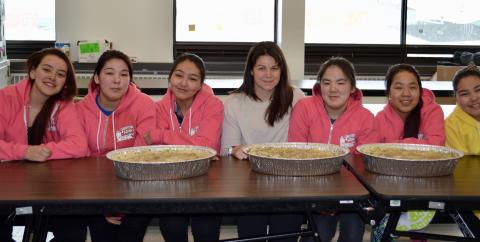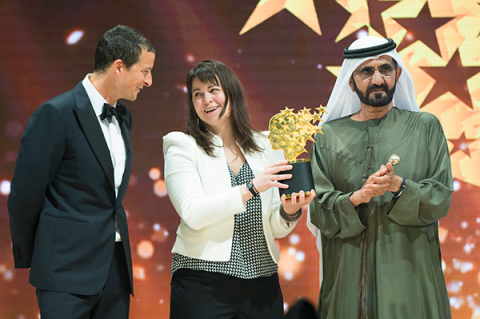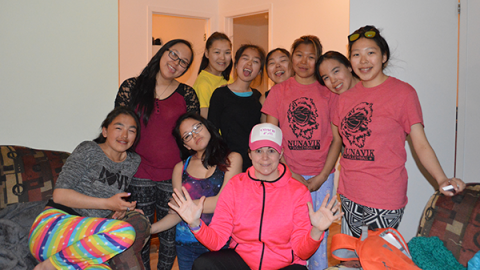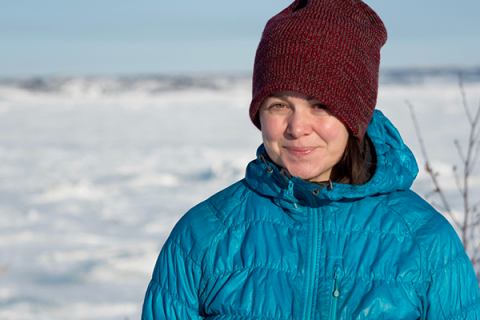
“I never used the word ‘inundated’ before,” teacher Maggie MacDonnell says with a mix of humour and mild exasperation, “but now is the time that I could put that into my vocabulary.”
MacDonnell is using her new word in an interview with Samaritanmag to describe the deluge of requests she’s been dealing with from Poland, the BBC, from Chile, from Germany, from Saudi Arabia” ever since winning the Global Teacher Prize of $1 million (USD) at a ceremony in Dubai back in March.
She received the award at the Global Education & Skills Forum 2017 from adventurer Bear Grylls, who jumped from a helicopter to deliver it to the ceremony, where the top 10 finalists were all onstage. The winner was announced by an astronaut on the International Space Station "80 miles up in the air."
Given annually by the Varkey Foundation, a non-profit organization dedicated to improving education for underprivileged children around the world, MacDonnell was selected from among 20,000 nominees representing 179 countries.
Although recently transferred to Kuujjuaq, Quebec — “temporarily, I hope," she says — as a teacher in the Inuit village of Salluit, the second farthest north community in the province, for six years MacDonnell witnessed the dramatic need for healthier living and diminishing prospects for the future in a population disproportionately hit by suicides, malnutrition, poor education, alcoholism and drug abuse.
She has worked assiduously to raise funds for the community, particularly her students, focusing on nutrition and fitness, and created a life-skills programme specifically for young women that has seen a 500 percent growth in girls’ enrolment because previous programmes were designed to help mainly boys, according to her bio on the Global Teacher Prize web site.

As for the million dollars, MacDonnell tells Samaritanmag, “I am currently in the process of registering an NGO that will use kayaking as an engagement tool for youth participation, cultural preservation and environmental stewardship. As you may know, the kayak was invited by the Inuit and is a tremendous cultural resource.”
The prize-money will be distributed in equal installments over the next 10 years, and it is a condition of the prize that the winner remain a classroom teacher for at least five years.
Samaritanmag spoke to MacDonell about the conditions of life in the North, the impact she's made and what needs to be a priority.
At the prize-winning ceremony in Dubai you were cited for “changing the lives of [your] students and transforming [your] community.” Was your original focus on using fitness programmes to help kids stabilize their lives, to get them healthier and to be more motivated?
It wasn’t my original focus, per se, but my background is in physical education and I love that. I find it’s probably always going to be a tool I use to connect with young people, but I don’t try to force it on the situation. For example, most of the girls I work with in my girls’ life-skills programme – they’re already disenfranchised and disengaged from physical activity culture. So with them I really had to do a lot of different things: from cooking programmes, from work placement, from active community service for them to get involved in, to art-based programmes like stained glass, canvas painting, things like that. But, of course, physical activity is something I love and as soon as I see an opportunity to apply that skill I would.
The life-skills programme I designed is for students who have dropped out of school or who are at risk of dropping out. If they’re at risk of dropping out, it’s probably because they’ve had a lot of failures within the school system and I’m not interested in recreating that classroom environment for them. I can look quickly at their report cards and their history and talk to their teachers and tell that they’re not interested in that now. Initially, when they come to me, it’s probably because they’re facing a lot of instability in their life and they have negative academic experiences. They want to drop out of school; their attendance is poor and they’re not very excited about it, so I’ve got to find practical projects where you’re learning. I mean, if you’re baking you’re learning about fractions all day — quarter cup of this, 15 ml of that — It’s all in there, but I’m not going to prove that in top-down style like a typical math class because they’re just going to drop out.
An interesting thing about the North: there really isn’t that social pressure to squeeze people into blocks like you might find in the South where parents are really pressuring their kids to be in school, where there’s social pressure that you should get to grade 10 or at least finish high school. And [in the South] you have other students and teachers that put pressure on you as well. That largely doesn’t work in the North much because there isn’t the pressure to be in school coming from their parents, because their parents or grandparents lived through the residential school system and are dealing with their own addictions and issues like that.
Some of the people might wish and hope that their kids will do well at school, but it isn’t like a tremendous pressure coming from those parents forcing the kids into the school system. You’ve got to do all that you can to make it attractive, to make it engaging, to make it exciting, to make it interesting, and to make it a safe and secure environment where the students will say, “Okay, I want to come to school today. I want to hang out with Maggie.” As we build that rapport, I can start discussing things. I can say, ‘Let’s read this novel today.” But I’m not going to do that on day one. Not at all. That might come out in month three after there’s been a lot of relationship building.
Is the biggest challenge to motivate these kids when they’ve mainly seen disillusionment in so many others?
It’s a mix of motivation [and] also addressing very real social barriers that are behind that lack of motivation. When you’ve lost 10 friends to suicide, it’s going to affect your own mental health. So that’s going to affect their daily lives. They’re living in an overcrowded house, which is not well-renovated, etcetera, and they’re getting poor sleep because of that. They’re sleeping on the floor of the living room with maybe two or three other people. And then, unfortunately, because of the inter-generational traumas in the community, they see people cope through alcohol and addiction so they find, not only are young people growing up in overcrowded run-down homes but in addition they’re exposed to a lot of domestic violence, exposed to alcohol and addictions and, of course, that’s going to eat in on your motivation and your mental health.
But I hate to individualize that issue [to Native Canadians]. It wouldn’t matter whoever was growing up in that situation, you would of course become less motivated, let’s say, for school, because you’re facing other pretty real, more urgent day-to-day challenges than working towards an 18- or 22-year master’s degree or a long-term plan like that.

Totally, and kids almost can see it as – and I’m not sure this isn’t too much language to put on it – but they almost see it as a destiny. They’ve lost a brother and a cousin and a best friend already and, you know, sometimes it gets to be a big thing just to get to the age of 16. It’s definitely a big issue.
Has there been an appreciable sense of turnaround in Salluit since you started your programmes, or is it still too soon?
I think there are changes. I’m not coming in as a researcher to independently research my own work, or how you distinguish this one cause or changing agent. There are a few things that I know I’m proud about and that I know I’ve worked with the students to do something farther out. One of those is that we created that fitness centre and that’s been going for over five years. Now it’s staffed and managed and run by my students. I’m very proud that those guys have taken ownership of it, creating employment … It’s open Monday to Friday and on weekends, and almost every evening, and they’re welcoming people to offer them another choice.
In the north, it’s lonely to be a healthy teenager. You’re a little silo, you know? By 12 most kids are smoking cigarettes, and soon that’s going to turn into marijuana. If you’re choosing to live a drug-free, or drinking- or partying-free life… if you’re choosing to make some other choices, it is lonely. Sometimes the power of that fitness centre was just a place where, if you wanted to make a healthy choice or were already doing it and wanting more support, you could come up there and… not be alone in your room or alone walking around the community being a non-weed smoker or a non-cigarette smoker or not partying that weekend. You could come up there and then… Wow! You could connect with 27 other people doing the same thing.
That became a whole new way for people to come together and support each other. I’m really proud of that. And I don’t work as a silo. The only way I could get anything done is through teamwork. We say at our school: Teamwork is dream work. I feel humbled sometimes to hold the [Global Teacher] prize because I know all the people that are really connected to that prize. For example: starting the Salluit Run Club. It was just trying to find ways for kids to be active, so I looked around and said, “Come for a run with me.” We worked from that and it started to build from two or three kids and now we’re probably at 40 people in that community that can run a 10k with no problem… There is a documentary about how they trained and fund-raised over $30,000 to travel to Hawaii to compete in a half-marathon.
I can see the fitness centre as a legacy, but everything still requires funding. In Canada, we’re not talking about how much under-funding indigenous communities are having to live with. You’re a Canadian and I’m sure you’re aware of some of the suicide issues. In the village of Salluit, we went through, at one time, 10 suicides in two years. How many more permanent staff in the field of social services or mental health have been added to that village? I would say I don’t think there’s any. We might now have an almost-full-time social worker associated with the school, kind of. How are we, as Canada, responding to this? I’m sure if you go up to Attawapiskat [in Ontario], where they live through a lot of stuff, what has been done in terms of bringing in more resources or cultivating more resources locally? I know the excuse might be, “Well, try to attract people.” Of course – it’s hard to attract people. You underfunded these communities for so long. You’ve got to address housing, you’ve got to address recreational facilities, you’ve got to address transport and accessibility, you’ve got to address why the food prices are skyrocketing, you know?

One really good thing about our School Board is that there’s a funding basket for [a programme] they call “Healthy Schools.” To me, as I see the North, there’s funding for what I call the “low hanging level”. There’s not enough funding to build my students a house, which is what they really need in the long term. I can go after and find [nutrition-related] grants for $15,000, $12,000, you know – $4,000, etcetera, etcetera. And I do hustle a lot to get that. I will say that sometimes that’s the biggest thing I’m doing as a teacher: chasing down that kind of funding. And, in addition, we would also do a lot of fundraising just with my students. Bake sales and spaghetti dinners, movie nights – things like that. The community is very generous in the way that they’ll try to support those initiatives. So probably every year we bring in $15,000 from a variety of different funders and different activities, also including our own school board and its relationship with the health board. And then we’d just maximize that to turn it into a healthy snack every day for the students.
What’s the ratio between government funds and the contributions of NGO’s (non-government organizations) in the North?
I can’t really answer that. I don’t think there’s that many NGO’s that fund here. There would be mining companies that you could see as a donor. What we would describe as the Regional Health Board, there would be money there. There’s the School Board, there can be money there. There’s what we call Landholding Organizations in each village – they’re locally run – they might put something back into the community. Major transportation providers, like airlines, they can provide donations or reduce costs for services. They can reduce air fares here, or I can get the local grocery store to sponsor a track meet. We’ll put on a movie night every Friday for eight months and generate, maybe, $5-, $6-, or $7,000. I can get some of the students to write letters with me, we’ll approach some of the mining companies, we’ll write something to the health boards, we’ll do additional fundraisers – that’s how it would all come together so that we’d have enough funding to, let’s say, go on a trip to Hawaii. We fundraised over $30,000 with my kids to help other northern youths.
There are so many different issues to deal with when you’re trying to improve living conditions in the North – with all the attention you’re now getting, do you think you can help determine priorities?
I really hope that Canadians, that the donor community here, the private sector, the government sector, too, will believe in what I’m doing and contribute. As an example of the cost of some of these issues here, in the region I live in the Senate reported that you need over 1,000 houses. When I say we need them – you won’t find homelessness here like you would in the South. You’re not going to see people sleeping outside, right? Because they will die, it’s that cold. So, what you have is a tremendous amount of over-crowding. People don’t even have the option to rent a place. You end up on a waiting list for 10 or 15 years just to have the privilege to rent a social housing unit. When we talk about the housing crisis, that’s what it looks like up here. Even me. If my employers didn’t provide me a house, I would have no option of a place to go and rent. Everything is occupied, there are no empty spaces in that sense.
So that’s just one issue. At least 100 units are needed in my community. Each unit probably costs around $350,000 at minimum. So how far can $1,000,000 go? I can build, what? Two houses, two-and-a-half houses for my students? I don’t say that to diminish the beauty of this award, I’m truly grateful for this funding and I know that we can do dynamic and engaging things with that, but when you look at some of the major, baseline, foundational issues that need to be addressed, it’s going to be very expensive. Either the tax payers are paying for it, or the kids are paying for it. And they’re paying for it with suicide.
When we talk about housing, we’re going to have to be talking about billions of dollars in the North to catch up with this issue. We’re so behind the curve with these social issues in the North. We underfund so much that we create situations where people are pretty much becoming used to committing suicide. They’re self-destructive and that falls into an easy narrative for outsiders to say, “Oh well, they have addictions, they have problems, blah, blah, blah…” Right? They think it’s the Inuit, it’s the natives… Those stereotypes become so easy to say because people don’t really understand how much things have been underfunded.
Sorry if I’ve been ranting, but you’re a Canadian and this is for a Canadian audience and I’d like to get that message out there.
WATCH DOCUMENTARY, SALLUIT RUN CLUB, BELOW:
Air Jordan 1 GS